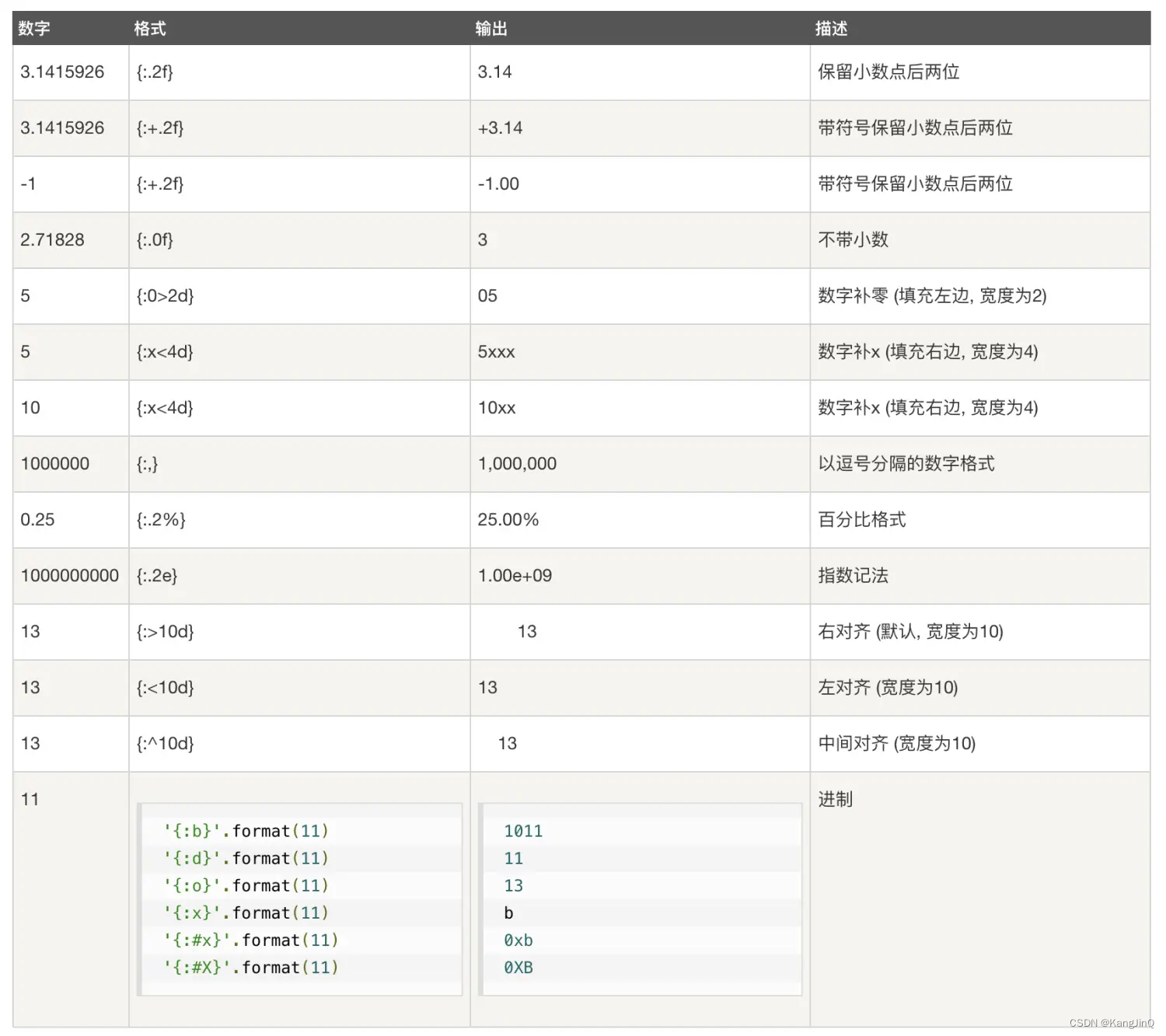一、基础输出
-
输出一句话
print("hello world.") ''' return: hello world. ''' -
输出变量&字符串
用逗号分隔开变量与字符串。其中变量和字符串中间会自动加入空格:name = "Kang" fruit = "apple" print("I'm", name, ", I like ", fruit) ''' return: I'm Kang , I like apple '''或用加号将变量转换为字符串类型与给定字符串拼接,字符串中间没有空格:
name = "Kang" age = 12 print("My name is " + name + ", I'm " + str(age) + " years old.") ''' return: My name is Kang, I'm 12 years old. '''
二、格式化输出
-
%占位符
几个常用的占位符:
%s-为字符串占位
%d-为整数占位
%f-为浮点数占位(默认6位)
%.nf-%f也可以对输出浮点数的位数进行规定,语法为%.nf,n为你想保留的小数点后n位数。
语法为:print("I'm %s" % string)name = "Kang" age = 15 height = 1.8746 print("My name is %s, I'm %d years old and My height is %f" %(name, age, height)) print("My height is about %.2f" % height) ''' return: My name is Kang, I'm 15 years old and My height is 1.874600 My height is about 1.87 ''' -
format()方法
format()方法的使用对象是一个字符串,字符串中需要用到{ }作为占位符。
format()方法中的变量值会依次填入到字符串中的{ }中。
但是此时,如果您需要在字符串中打印==花括号“{ }”==的话,您需要加倍打印{{ }}即可避免format()方法在您想打印的花括号上进行数据的填充。
format()方法也可以用%.nf的方法格式化浮点数位数,但是在.nf前需要加”:",记作:.nfname = "Kang" height = 1.8746 print("My name is {}, My height is {}.".format(name, height)) print("My height{{}} is about {:.2f}.".format(height)) ''' return: My name is Kang, My height is 1.8746. My height{} is about 1.87. '''补充,附一张图

-
f-string构建字符串
在要输出的字符串外加一个字符f,再在字符串中加入{变量},即可将变量值嵌入字符串中。
这种方法最简单
语法为 print(f"some string {value}")
和format()方法相同,f-string方法也可以用%.nf的方法格式化浮点数位数,但是在.nf前需要加":",记作:.nfname = "Kang" age = 15 height = 1.8746 print(f"My name is {name}, I'm {age} years old and My height is {height}") print("My height is about {height:.2f}") ''' return: My name is Kang, I'm 15 years old and My height is 1.874600 My height is about 1.87 ''' -
控制换行
print输出时,可以使用
end参数来控制是否换行。print("第一行", end=" ") print("这不是第二行") ''' return: 第一行 这不是第二行 '''
三、输出到文件
基础知识
open()函数参数介绍:
file:文件路径(绝对、相对路径);
mode:打开方式,有【r、w、a等】模式;
- r:只读模式;
- w:写入模式(原有内容删除);
- a:追加模式(原有内容保存);
encoding:编码方式。有中文乱码的话,要使用encoding='utf-8'
file = open(r"./test.txt", "w",encoding='utf-8') # 打开文件
print("这些文字将被写入文件", file=file) # 输出到文件
file.write("也可以这样写入")
file.close()# 关闭文件
'''
output:
这些文字将被写入文件
也可以这样写
'''
如果要写一些变量的数据到文件中的话,和之前介绍的






















 1239
1239

 被折叠的 条评论
为什么被折叠?
被折叠的 条评论
为什么被折叠?








